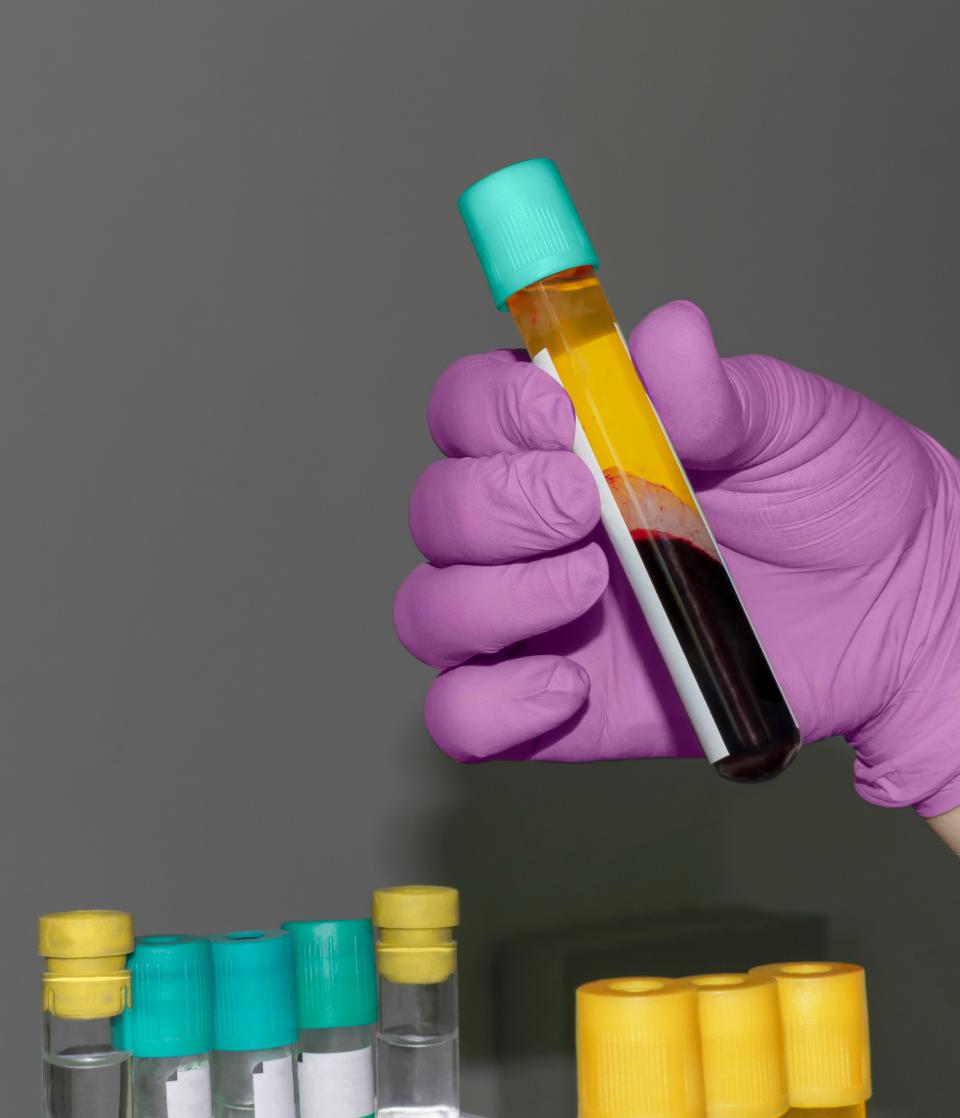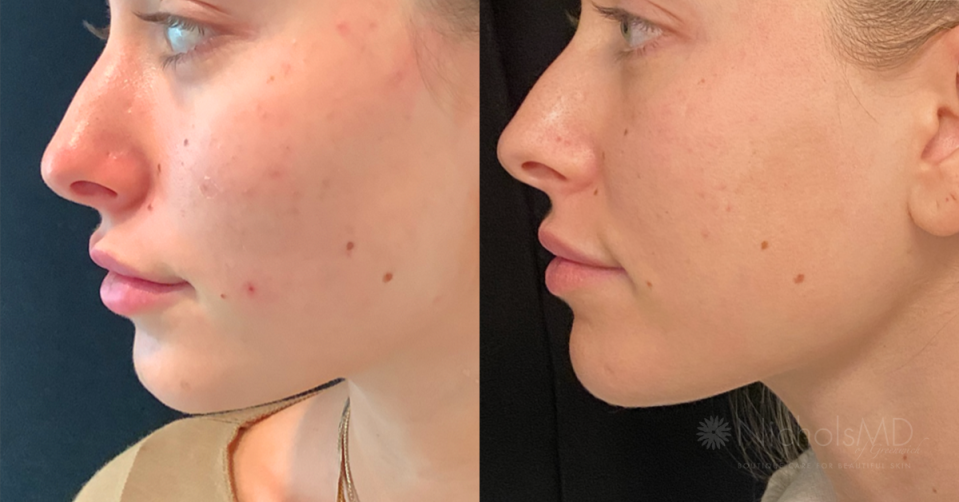What Exactly Are PRP Facial Treatments?

Getty Images
You've likely heard of PRP facial treatments—colloquially known as vampire facials—or, at the very least, seen the startling photos on social media. (Remember Kim Kardashian’s viral post-treatment selfie?) What could be mistaken for gruesome Halloween makeup is the nickname for a microneedling treatment using platelet-rich plasma—a component of your blood that can lead to impressive results when absorbed into your skin.
Vampire facials "combine the powers of microneedling and PRP," says Melissa Doft, MD, a board-certified plastic surgeon in New York City. "During a traditional microneedling treatment, needles create tiny insults in the skin, stimulating the skin to repair itself with new collagen and elastin.” But in a vampire facial, this is coupled with platelet-rich plasma, which “contains growth factors to help stimulate repair.”
Beyond the shock factor, PRP facials have gained popularity due to their proven ability to enhance the skin's overall appearance. The treatment can visibly improve its texture, tone, and radiance by stimulating cell repair and boosting collagen—all undeniably enticing benefits However, there's more to consider before scheduling an appointment. Ahead, we break down everything you need to know about vampire facials, including their benefits, what to expect during your session, and before-and-after pics.
Meet the experts:
Melissa Doft, MD, is a board-certified plastic surgeon in New York City.
David Kim, MD, is a board-certified dermatologist based in New York City.
Ava Shamban, MD, is a board-certified dermatologist in Beverly Hills.
Azadeh Shirazi, MD, is a board-certified dermatologist at La Jolla Laser Dermatology in California.
Smita Ramanadham, MD, is a double board-certified plastic surgeon and founder of SR Plastic Surgery in New Jersey.
Karan Lal, MD, is a board-certified dermatologist and the director of cosmetic dermatology at Affiliated Dermatology in Scottsdale, Arizona.
Kim Nichols, MD, is a board-certified dermatologist and founder of NicholsMD.
Mona Gohara, MD, is a board-certified dermatologist in Hamden, Connecticut.
In this story:
What exactly is PRP?
When blood is placed into a centrifuge, it separates into three distinct layers: plasma on top, platelets and blood cells in the middle, and red blood cells at the bottom. PRP comes from the center part, known as the "serum portion," says Beverly Hills-based board-certified dermatologist Ava Shamban, MD. This powerful substance is critical to the treatment because it promotes cell repair and stimulates collagen and elastin production, which are vital to maintaining firm and smooth skin. Crucially, the facial harnesses the power of your own plasma obtained from a blood sample—not someone else's.

Test tube with plasma and blood in the doctors hand. Plasma with antibodies to Covid-19. PRP. Close up, copy space.
Getty ImagesWhat are the benefits of a PRP facial?
Yes, they’re bloody, but there are numerous benefits to getting PRP facials. Some of them include:
It makes your skin appear tighter and smoother: When platelet-rich plasma is applied to the skin in a non-invasive procedure, it triggers cell turnover and boosts the production of collagen and elastin, resulting in a firmer, tighter, and more supple complexion, Marina Peredoper, MD, a board-certified dermatologist and associate clinical professor of dermatology at Mount Sinai Hospital in New York City, previously told Allure.
It helps with scarring: Microneedling with PRP can churn out fresher skin cells and promote healing, leading to a visible improvement in the appearance of acne scars. Several studies have looked at the potential scar-improving benefits of the procedure, with promising results. For example, a 2014 study showed that microneedling with PRP can improve scars more effectively than topical vitamin C.
It fades hyperpigmentation and evens skin tone: In a comprehensive analysis of PRP therapy published in 2021, the authors note that previous studies have demonstrated the ability of PRP to effectively decrease melanin production, thus reducing excess pigmentation and resulting in a more even skin tone.
What is it like getting a PRP facial?
Wondering how your blood goes from coursing through your veins to being used in a vampire facial? Well first, your provider will apply a topical numbing cream to your face, allowing it to take effect while they go about the next step: drawing blood from your arm. Generally, they will collect around 10 to 15 milliliters of blood, which equates to one tablespoon, says Karan Lal, MD, a board-certified dermatologist and director of cosmetic dermatology at Affiliated Dermatology in Scottsdale, Arizona.
After collecting your blood, the practitioner spins it in a medical centrifuge to separate the platelet-rich plasma (PRP) from the red blood cells. This sets the stage for the main event of the facial: they use a specialized microneedling device to create tiny holes, or microchannels, on the skin's surface. These microchannels serve as pathways for the extracted PRP, which your provider applies topically. The whole process takes around an hour and a half in total, according to Lal.
After a PRP facial, your skin may look red, slightly swollen, and potentially itch, though it shouldn't be painful, says Lal. The redness can persist for anywhere from 12 to 24 hours, says Doft, and there's also a chance your skin may peel for a few days. To maximize the benefits of your treatment, Lal suggests avoiding makeup until the peeling has subsided.
Although the term "vampire facial" specifically refers to PRP combined with microneedling, there are other ways to take advantage of the benefits of platelet-rich plasma, even if they don't fit the vampire facial definition. For instance, according to Kim, injecting PRP superficially under your skin is another effective way to stimulate collagen production and rejuvenate your skin. Your dermatologist can also combine PRP treatment with other skin procedures like microdermabrasion or resurfacing lasers like Fraxel can amplify its effects. Whichever you choose will ultimately depend on your specific skin-care goals and the expert advice of your provider.
PRP Before and After

vampire facial before and after
Vampire facials have earned a reputation for producing impressive results. According to Kim Nichols, MD, a board-certified dermatologist and founder of NicholsMD, the best way to achieve optimal results is “a series of at least six PRP injection treatments, spaced about four weeks apart." However, patients can still expect to see improvements after just one session, evidenced by the accompanying image. In the case of the patient shown in the above photos, Nichols says, "You can see a visible reduction in redness, diminished acne scarring, and improved overall skin texture."
What are the risks of getting a PRP facial?
While the sight of blood-splattered selfies may be unnerving, the risks associated with a PRP treatment are minimal since it uses your own blood, says Ramanadham. "There is little risk of reactions," she adds. Doft shares the same view and cites the potential risks as scarring, sun sensitivity, and infection on the skin surface or at the injection site.
PRP and HIV Risks
In April 2024, the CDC released a report about HIV transmission linked to PRP facials done at a New Mexico spa. The investigation initially looked at 20 people who had received PRP facials at the spa and were at risk of exposure to HIV. (The team also looked at 39 people who had received other injection services at this location.) The team’s findings showed that three people were found to have HIV infections related to the PRP facials they received at the spa, due to unsterile practices.
The CDC did not name the spa, but in September 2018, the New Mexico Department of Health encouraged clients of VIP Spa who have gotten injectables there to be HIV tested, as it found that the spa in Albuquerque may have exposed patients to pathogens like HIV and hepatitis B and C. (VIP Spa has since shut down.)
“This investigation is the first to associate HIV transmission with non-sterile cosmetic injection services,” says the report. And while this information is certainly unsettling, board-certified Mona Gohara, MD, says it’s not a reason to write off the procedure completely. “People should not stop getting PRP facials,” she says, “This incident is very unfortunate and should never have happened. In the right hands, this procedure is safe.”
How to ensure your safety during a PRP treatment
“Avoid medspas with unlicensed providers,” says Dr. Gohara, emphasizing the importance of seeing a board-certified dermatologist for your PRP facial. Your doctor will likely administer the treatment themselves, or have a licensed physician assistant or nurse practitioner in their practice do so. “They are all under strict safety and infectious disease protocol,” Dr. Gohara adds.
These protocols ensure you get your PRP facial in a sterile environment. Some standards that your doctor is required to uphold include the “labeling of blood products and the discarding of used needles/sharp objects in biohazard disposals immediately and safely,” Dr. Gohara says. Before getting your facial, she suggests asking your doctor what procedures they follow and how blood products and used instruments are handled.
Gohara continues, “Dermatologists are trained to take care of the skin with 12 years or more of school—there is a reason for that. Caveat emptor, it can be a matter of life or death.”
Who benefits most from PRP treatments?
Those with fine lines and wrinkles, high levels of sun damage, or anyone who desires a fresher, more even-toned complexion are ideal candidates for the vampire facial, Shamban says. However, you should avoid PRP treatments if you have a history of blood diseases, including clotting or bleeding disorders.
How much does PRP cost?
How much PRP costs is based "on the area of the country, who's performing it, and the process involved in extracting the platelets and the amount of PRP that's harvested," says Shirazi. Both Doft and Lal agree that the cost of a vampire facial can vary, with Doft stating that it can range from $1,500 to $2,000, while Lal's office charges $1,000 per session.
Another important thing to keep in mind is that your provider may recommend multiple sessions, adding up to an even higher final cost.
PRP Pros and Cons
The "pros" of a vampire facial include its minimally invasive and non-surgical nature and its ability to improve the skin's overall appearance while targeting specific issues like acne scars, hyperpigmentation, and sun damage. The most notable con is the price tag. "This is a costly procedure, and results are not guaranteed," cautions Ramanadham. Also, certain supplements or medications could potentially interfere with platelet function, so it's crucial to discontinue them beforehand. "Blood thinners, aspirin, ibuprofen, garlic, turmeric, and arnica are examples of supplements or medications that can affect platelets," she explains.
Read more about beauty treatments:
Now, watch as an Allure insider gets a bee venom facial:
Originally Appeared on Allure

